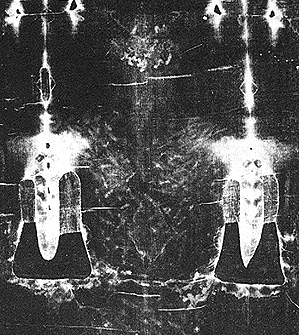 by
Fr. Hilary Conti, O.S.B.
by
Fr. Hilary Conti, O.S.B.
|
|
|
|
|
|
|
|
|
|
|
|
|
|
|
|
|
|
SHROUD SERIES, Part 3:
The Flagellation
 by
Fr. Hilary Conti, O.S.B.
by
Fr. Hilary Conti, O.S.B.
continued from Part 2...
The medical doctor then turned toward the rear image of Christ. He pointed to some kind of white spots scattered all over the body. He said, “...these spots across the shoulders and the back are bruises caused by the flogging. The bruises are so clear that from their position we can reconstruct how the punishment was carried out. Our Lord was tied to a post with His hands above his head; it is very probable that His feet were also tied to the post in such a way that He could not move or turn around to avoid the blows. There were two men who beat Him, one on each side, as you may see from the direction of the bruises. Because our Lord was tied and could not move, the floggers with easy and considerable precision applied the whip starting possible from the shoulders all the way down to the legs. The strokes are not over-imposed, but one after the other at equal distance, at about one-and-a-half or two inches apart. We have been able to count the number of blows: about 60. That is a sign that it was Roman soldiers who applied the flagellation because for the Jewish people there was a law limiting the number of strokes (during a scourging) to 40, and they used to give one less out of mercy. St. Paul, for example, in his letters tells us that five times he received 40 lashes less one; that was the legal punishment. For the Romans, however, there was not law limiting the number of blows; it was up to the officer to say when it was enough.”
I was thinking within myself, while the doctor was talking about he Shroud, how remarkable is the continuity with the Bible: Jesus a man of suffering. The prophet Isaiah gave a description of the future Savior and described him as a man of suffering. “My servant will be despised and rejected by men, a man of sorrow and familiar with suffering. A man to make people screen faces; he was despised and we took no account of him” (Is. 53:2). Eventually Jesus came, He was despised, rejected and finally crucified. Not only that, but when He went back to Heaven, He left for the future generations, for us today, a photograph - a photo not showing Himself performing a miracle, not of His transfiguration, not praying in the solitude of the mountain, but while lying dead in the sepulcher and on His Body are visible all the wounds and bruises of the crucifixion. The continuity of the mystery of suffering in the Bible is overwhelming.
Now I understand better why Jesus was frightened and perspired blood in the Garden of Olives. Jesus had been looking forward to the crucifixion as the climax of His life on earth; He called it “my hour”. But when the time had actually come, He was frightened, He pleaded with God, “...let this chalice pass from me”; He called three apostles and asked them to keep Him company, and He repeated His request three times. He could have said, no; but He had such a love for the Father and for us that He could not. He consented by saying, “... may thy will be done.”
The
piety of the speaker, the two impressions of Jesus crucified in the photos
of the Shroud and the presence in the Cathedral Church of the real Shroud,
made us feel closer to Jesus than we have ever experienced before.
|
|
|
|
|
|
|
|
|
|
|
|
|
|
|
|
|
|